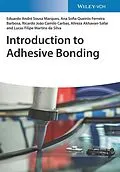Introduction to Adhesive Bonding
A step-by-step introduction to basic principles and practical applications of adhesive bonding, designed for students and professionals alike
Adhesive bonding-the process of joining two surfaces using glues, epoxies, plastic agents, and other adhesives-is a major technique with wide applications in industries as a diverse as aerospace, footwear manufacturing, and food packaging. Adhesive bonding holds several advantages over conventional joining techniques, such as uniform stress concentrations, protection of the bonded surfaces or joints, and the ability to join a variety of different materials and irregular surfaces.
Introduction to Adhesive Bonding provides an accessible overview of the principles and common applications of adhesive bonding. Using a systematic approach, the authors thoroughly explain each step necessary to achieve a successful adhesive bond, including surface preparation, bonding agent selection, design and construction of bonded joints, health and safety considerations, and quality control. Readers are provided with both the theoretical foundation and practical information required to plan and complete their own adhesive bonding projects. This comprehensive yet reader-friendly volume:
- Highlights the inherent advantages of adhesive bonding in various applications
- Describes the use of adhesive bonding in the development of novel and advanced projects in different industries
- Features numerous real-world examples of adhesive bonding in areas such as the transportation industry, civil engineering, medical applications, and sports equipment
- Discusses how adhesives enable development of new products and constructions of reduced weight and size
- Identifies important limitations and durability concerns of the use of adhesives in specific applications
Introduction to Adhesive Bonding is an ideal textbook for undergraduate or graduate Engineering and Chemistry programs, and a useful reference for researchers and industry professionals working in fields such as Engineering, Surface and Polymer Chemistry, and Materials Science.
Autorentext
Eduardo A. S. Marques, Post-doctoral researcher, Institute of Science and Innovation in Mechanical and Industrial Engineering (INEGI), University of Porto, Portugal.
Ana S. Q. F. Barbosa, Post-doctoral researcher, Institute of Science and Innovation in Mechanical and Industrial Engineering (INEGI), University of Porto, Portugal.
Ricardo J. C. Carbas, Post-doctoral researcher, Institute of Science and Innovation in Mechanical and Industrial Engineering (INEGI), University of Porto, Portugal.
Alireza Akhavan-Safar, Post-doctoral researcher, Institute of Science and Innovation in Mechanical and Industrial Engineering (INEGI), University of Porto, Portugal.
Lucas F. M. da Silva, Full Professor and Director of the Integrated Master in Mechanical Engineering Program, Department of Mechanical Engineering, University of Porto, Portugal.
Klappentext
A step-by-step introduction to basic principles and practical applications of adhesive bonding, designed for students and professionals alike
Adhesive bondingthe process of joining two surfaces using glues, epoxies, plastic agents, and other adhesivesis a major technique with wide applications in industries as a diverse as aerospace, footwear manufacturing, and food packaging. Adhesive bonding holds several advantages over conventional joining techniques, such as uniform stress concentrations, protection of the bonded surfaces or joints, and the ability to join a variety of different materials and irregular surfaces.
Introduction to Adhesive Bonding provides an accessible overview of the principles and common applications of adhesive bonding. Using a systematic approach, the authors thoroughly explain each step necessary to achieve a successful adhesive bond, including surface preparation, bonding agent selection, design and construction of bonded joints, health and safety considerations, and quality control. Readers are provided with both the theoretical foundation and practical information required to plan and complete their own adhesive bonding projects. This comprehensive yet reader-friendly volume:
- Highlights the inherent advantages of adhesive bonding in various applications
- Describes the use of adhesive bonding in the development of novel and advanced projects in different industries
- Features numerous real-world examples of adhesive bonding in areas such as the transportation industry, civil engineering, medical applications, and sports equipment
- Discusses how adhesives enable development of new products and constructions of reduced weight and size
- Identifies important limitations and durability concerns of the use of adhesives in specific applications
Introduction to Adhesive Bonding is an ideal textbook for undergraduate or graduate Engineering and Chemistry programs, and a useful reference for researchers and industry professionals working in fields such as Engineering, Surface and Polymer Chemistry, and Materials Science.
Inhalt
Preface xi
1 Benefits, Limitations, and Applications of Adhesive Bonding 1
1.1 Definition of Basic Concepts 2
1.2 Historical Context on Adhesive Bonding 3
1.3 Benefits and Limitations of Adhesive Bonding 4
1.4 Examples of Current Applications of Adhesive Bonding 8
1.4.1 Transportation 8
1.4.1.1 Aeronautical Industry 8
1.4.1.2 Road Transport and Rail Industry 11
1.4.1.3 Naval Industry 13
1.4.2 Civil Engineering 15
1.4.2.1 Tiling 15
1.4.2.2 Floor andWall Covering 15
1.4.2.3 Anchoring Systems 15
1.4.2.4 Building Facades 16
1.4.2.5 Wooden Construction 17
1.4.3 Labelling and Packaging Industry 18
1.4.3.1 Labelling of Consumable Products 18
1.4.3.2 Packaging 18
1.4.4 Medical Applications and Devices 19
1.4.5 Electronic Devices 23
1.4.6 Sport Equipment 23
1.4.7 Footwear 24
2 Principles of Adhesion 27
2.1 Forces Associated with Adhesion 28
2.2 Surface Roughness 31
2.3 Wettability 32
2.4 Adhesion and CohesionWork 35
2.5 Spreading 36
2.6 Adhesion Theories 37
2.6.1 Adsorption Theory 37
2.6.2 Mechanical Theory 38
2.6.3 Diffusion Theory 41
2.6.4 Electrostatic Theory 41
2.7 Defects andWeak Spots in Adhesive Joints 42
3 Surface Preparation 45
3.1 Objectives of Surface Preparation 45
3.2 Classes of Substrate Materials 47
3.2.1 Metals 47
3.2.2 Polymers 47
3.2.3 Composites 48
3.2.4 Other Materials 49
3.3 Surface Preparation Processes 49
3.3.1 Passive Processes 51
3.3.1.1 Passive Chemical Processes 51
3.3.1.2 Passive Mechanical Processes 55
3.3.2 Active Processes 59
3.3.2.1 Active Chemical Processes 59
3.3.2.2 PhysicalChemical Processes 62
3.3.3 Primers and Adhesion Promoters 65
3.4 Conservation of the Post-treatment Surface 67
4 Main Families of Adhesives and Adhesive Selection 69
4.1 Typical Composition of a Modern Adhesive 69
4.2 Methods for Adhesive Classification 70
4.2.1 Molecular Structure 70
4.2.1.1 Thermosets 71
4.2.1.2 Thermoplastics 71
4.2.1.3 Elastomers 72
4.2.1.4 Hybrid Materials 72
4.2.2 Physical Form 74
4.2.3 Mechanical Properties 74
4.2.4 Hardening and Implementation Method 75
4.2.4.1 Hardening by Chemical Reaction 75
4.2.4.2 Hardening via Physical Processes …
